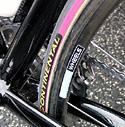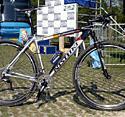
Recently on Cyclingnews.com |
Tech News – May 13, 2004Edited by John Stevenson Got tech? Send press releases, news, and tech questions to the Cyclingnews tech-heads. Shimano prepping new carbon wheels
The Giant bike Erik Zabel is currently riding at the Peace Race may not have a carbon frame (as we pointed out a couple of days ago, it appears to be a custom aluminium job) but Zabel's wheels are almost definitely prototype Dura-Ace hoops with carbon fiber rims.
Shimano's Chris Distefano was cagey about exactly what Zabel and the T-Mobile boys are rolling around on, but told us, "as you know, we recently began sponsoring the T-Mobile squad and we have had numerous wheelsets under them throughout the spring for testing." It's pretty clear from the pics that these are Shimano Dura-Ace wheels from the design of the spoke nipple insertion at the hub, but there's clearly no metal at the braking surface. It looks very strongly as if Shimano is developing a carbon version of its WH-7800 Dura-Ace wheels, with a conventional spoking pattern instead of the paired spokes of the current Shimano carbon wheels, the WH-7701. Price: Your guess is as good as ours First national win on 29in MTB?
Jelmer Pietersma recently won the Netherlands national MTB championships in the under-23 category, becoming in the process the first rider we're aware of to win a cross-country national championship on a bike with '29-inch' wheels. The UCI recently changed its regulations to allow '29-inch' bikes to race at UCI-sanctioned events. The bikes actually have the same 700C rim size as road bikes, but use fatter tyres - claimed advantages include better rolling over uneven ground. According to Pietersma's team, the regulation change has led to substantial debate in Dutch mountain biking because the new rules don't say anything about tyre width. Riders have therefore been turning up at mountain bike races with cyclo-cross bikes, something mountain bikers were apparently unhappy about, perhaps because they hadn't thought of it first. A team spokesman says the team wants "to promote a 29inch mountain bike, not promoting cyclo-cross bikes into our competition." To this end the team believes "putting a normal mountain bike tire size (44-622) into regulations makes it impossible for cyclo-cross bikes to be allowed." As someone who was deeply involved in mountain bike racing in the UK the first time this debate rolled round in the late 1980s, I can't help but think this is all a bit silly. If a 'mountain bike' race course is so technically undemanding that it can be won on a cyclo-cross bike, then so be it. Either redesign the course, or put up with it. Artificial equipment rules to exclude a type of bike that you don't like is exactly the sort of nonsense that drove people away from road racing and into mountain bike racing back in the '80s and early '90s. The original rule against tyres bigger than 26in was introduced on 'safety' grounds - on a well-designed mountain bike course a cyclo-cross bike would be a hazard, the reasoning went, even though cyclo-crossers seemed to survive events like the UK's Three Peaks Race on a course that no sane person would tackle on anything but a mountain bike. No mountain bike racer I talked to at the time wanted to exclude the 'crossers, especially as we'd found ourselves being welcomed warmly at their events. But the rule happened anyway, because it'd never do to actually foster good relations between different branches of cycling. Anyway, my editorialising aside, Jelmer Pietersma's bike is a rather nice Nishiki Bigfoot 29inch, with Maxxis tires, RODI wheels, Truvativ parts, Crank brothers pedals, and a Selle San Marco saddle. Total weight is claimed to be 9.5kg.
CycleOps bags up and blocks out
CycleOps has added two handy new widgets to its range, a bag to make it easier to transport a CycleOps trainer, and a multi-position wheel block to bring the front wheel up to the right level. The riser block can be stacked to raise the front of the bike to simulate a climbing position, and there's enough room in the trainer bag for a helmet and other essentials. Prices: Riser block - $15.99; Trainer bag - TBA More info: www.cycleops.com
Naviion shows the wayHere's probably the most unusual cycle computer we've yet heard of. The Czech-made naviiON (which I'm going to punctuate Naviion from now on because alt.capitalisation of product names makes my brain hurt) uses a 16-bit processor to record and calculate your route, based on distance and altimeter data. Rather than using a GPS it, in effect, calculates your position by dead reckoning. You can then download a ride profile to your PC from the included Compact Flash card (a USB card reader is also included). Features include an altimeter, altitude profile graphing, thermometer, point-to-point 'e-guide' system, voice recorder with built-in microphone and speaker, training diary and a heck of a lot more. The Naviion uses a Sigma Sport handlebar mount and runs off two AAA batteries. The package includes Naviisoft software for graphing and recording rides and Naviion's firmware can be upgraded with an optional serial cable as the manufacturer improves it. Price: $199 Campagnolo race support goes nationwideCampagnolo USA's race support program is expanding nationwide from its previous area of operations on the east coast. Program director Butch Balzano and his fleet of Volvo cars will be appearing at over 80 races across the US this year. Balzano described the expansion of the program, saying "Unlike previous years where service cars stayed in New England and the East Coast, Campagnolo Race Service and Volvo Cars of North America will have cars on the East Coast, Midwest, and West Coast for greater event coverage." For Campagnolo, it's a way of supporting the company's many loyal customers in the amateur ranks. "Providing service to the thousands of Campagnolo equipped riders who race at an amateur level was our goal in supporting Butch's program. Campagnolo has always sponsored pro level teams and this was an opportunity we didn't want to miss," said Richard Storino of Campagnolo USA. The heart of the Campagnolo Race Service program will be five 2004 Volvo XC70 Cross Country wagons decked in eye-catching full graphic wraps. |
||||||
|







